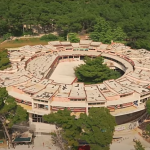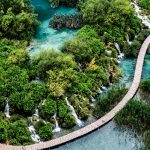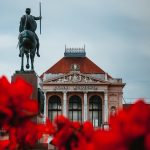The dynamic Association of Baranja Recreational Cyclists organised on May 19th its first official event – the Baranjski Surduci cycling tour. The Lajmir lake near Beli Manastir was the starting point of this cyclo-tourist expedition.
The artificial lake was created in the early 20th century when it was excavated for the needs of the former Belje sugar factory, so it is understandable that its unofficial name is Sugar Lake. About twenty years ago, the sugar factory ceased its operations, so the lake has lost its original purpose. Several years ago, it was turned into a recreational and excursion area. A nearly four-kilometre-long cycling trail was built on the embankment along the Karašica river, which feeds the lake, with rest areas and a skate park.
For those who do not know, there are two Karašica rivers in Croatia. One is located in Slavonia, formed by the joining of the Vojlovica and Čađavica rivers, and enters the Drava river near Petrijevac, while the other is located in Baranja, starting at Pecsvarad in Hungary and flowing into the Danube near the Battle of Batina monument.
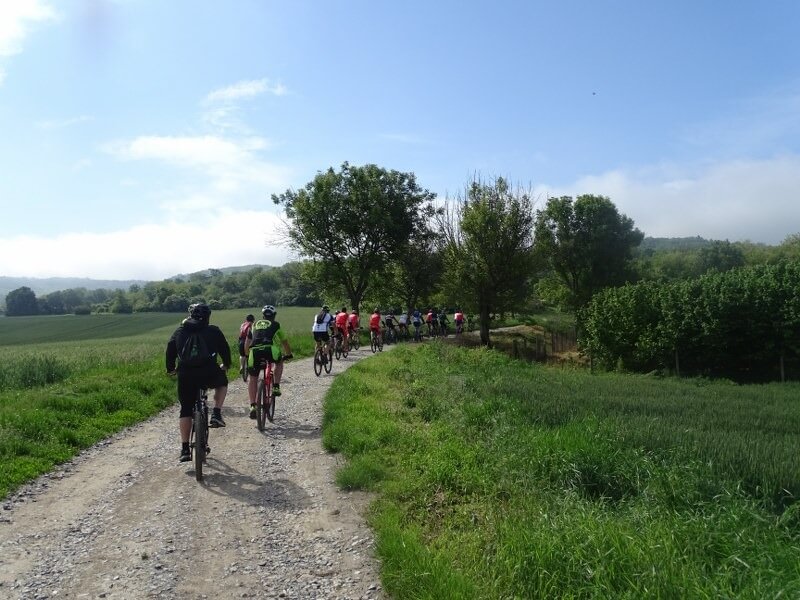
After receiving the starting packages that included a lunch voucher and a drink, a backpack, a t-shirt, a bidon, a pen and a notebook with the event logo (everything for just 60 kuna) and an obligatory group photograph, sixty brave bikers went towards Banovo Hill to get to know its natural beauties and attractions, especially the surduks.
Surduks are steep grooves on Banovo Hill, created by the descent of the rainwater from the hill. Surduks on Banovo Hill can be a few metres tall because the roots of trees on the sides prevent their collapse. When the crowns of these trees join, you are left with the impression of being in a tunnel.
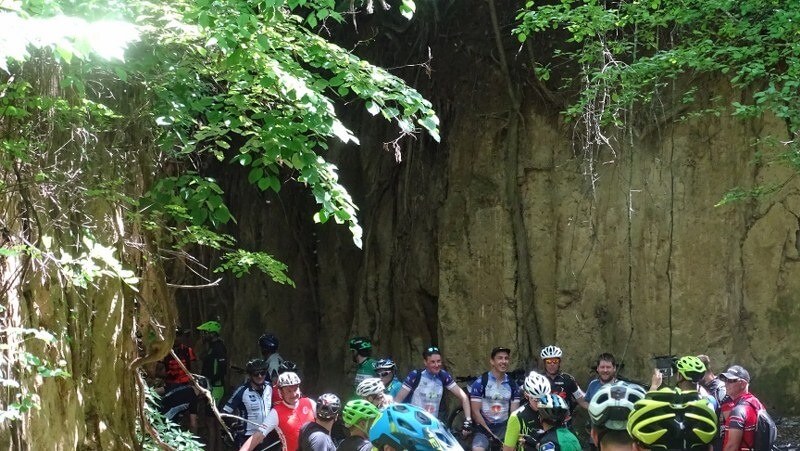
The originator of the event is Zoran Kovač from Beli Manastir, who knows surduks like his pocket, so much so that he can cycle through them in complete darkness. It is fortunate that Zoran did not keep his knowledge of surduks just for himself, but has decided to share it with others.
I thought I knew Banovo Hill well, but when I started cycling with Zoran my self-confidence when it comes to the knowledge about this Baranja hill collapsed in a very short time. Still, live and learn, and you should always spend time with people who know more than you do.
After a short ride on a bicycle trail which served to warm us up, cyclists went to Branjin Vrh, a suburb of Beli Manastir, and then towards the Baranja hill. Initially, the Hungarian name of Branjin Vrh was Baranyavar, and once this was the centre of the entire historic Baranja County. The part of Baranja which is now in Croatia is just a small part of the former Hungarian Baranja County (Baranya Varmegye), which Hungarians also call the Drava Triangle. The seat of today’s Hungarian Baranja County is located in Pecs, and it stretches to the north as far as the village of Mekenyes, which is about sixty kilometres from Pecs.
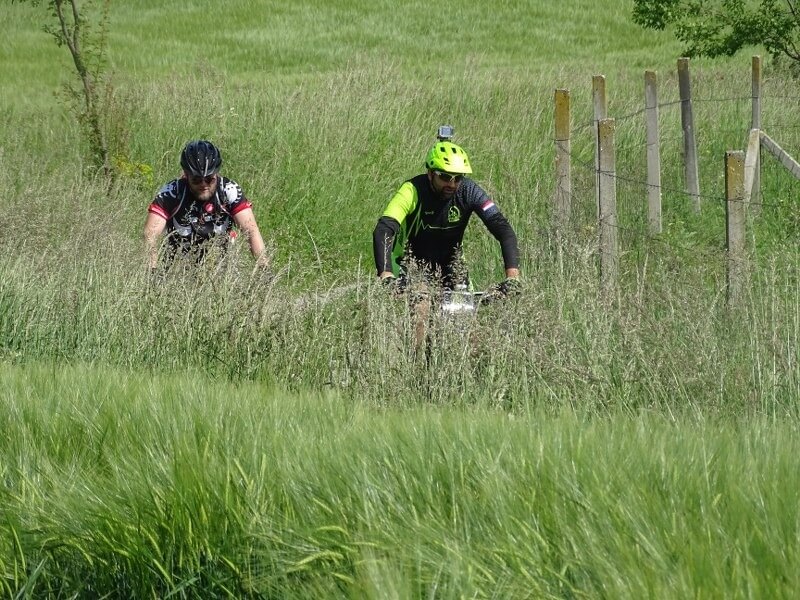
On a trail at the end of Branjin Vrh, the cyclist stopped at the cross to once again count ourselves and provide final instructions. Some prayed for good luck. The first rest point was at Popovac, at the shrine of Our Land of Lourdes, located on the other side of the hill.
In the initial phase, we partly used the multifunctional trails of the town of Beli Manastir. It is a tourist product which uses the part of Banovo Hill located within the administrative boundaries of the town of Beli Manastir as a destination for the recreation of locals and tourists. At about 50 locations on the trail, signposts have been set up, and there is also a mobile walk&bike app that contains a map of the hill, showing your location, and can be used offline.
After that, we went to the Belje wine road stretching from the Beli Manastir to the new Belje winery in Kamenac. It is asphalted and suitable for tourist buses. The central part of the wine road includes a viewpoint with a beautiful view of vast vineyards on surrounding rolling hills. We did not stay for too long on the asphalt. We turned right and rode on the grass along the edge of the vineyards, then turning into a damp, dark and muddy surduk.
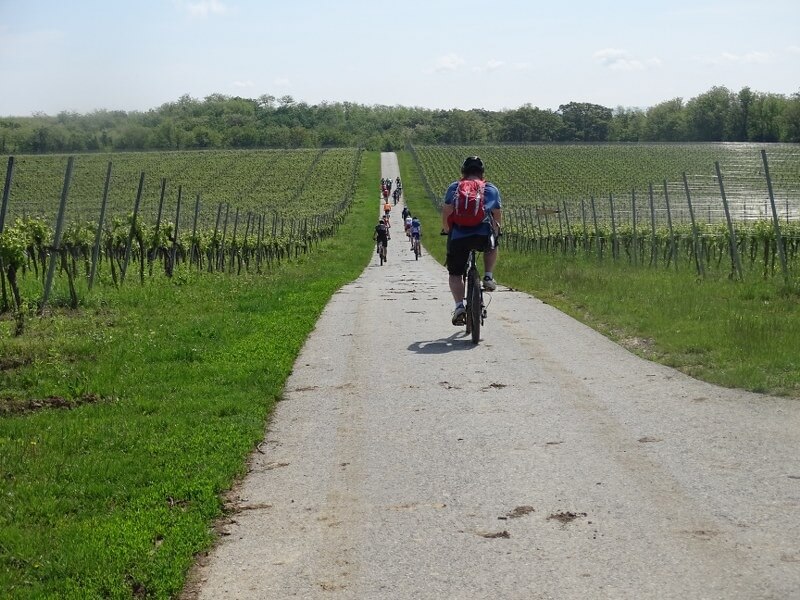
It was raining in Slavonia and Baranja for nearly the entire week ahead of the event, so many surduks were muddy, wet, especially those in the form of a tunnel, where the surrounding vegetation did not allow the sun rays to penetrate. In some places, the trail turned into a bog, so we had to ride on the thick grass next to it.
We were hoping for better terrain after leaving the surduks, but it was quite the opposite; we came across substantial muddy puddles that forced all participants to stop and lift the bicycles on their shoulders. While descending towards Popovac, we enjoyed a fantastic view of the hills in the neighbouring Hungarian Baranja, Villany-Hegyseg and its highest part called Szarsomlyo.
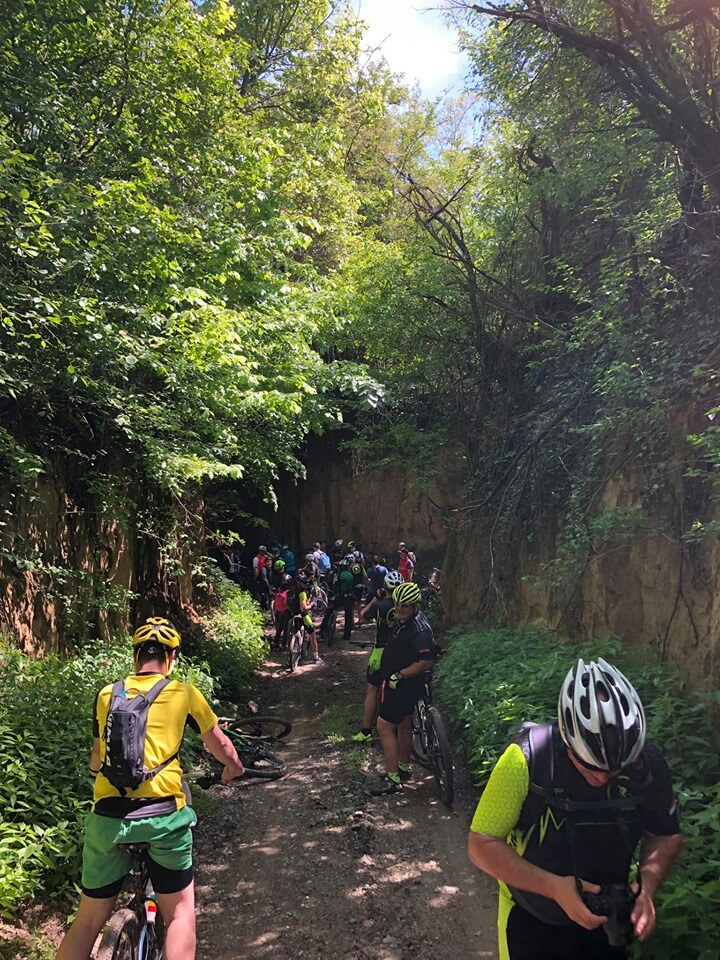
A well-deserved rest in Popovac, with water, juices, bananas, cakes, crescent rolls, and local cured meat delicacies. Although it was Sunday, the mayor of Popovac municipality Zoran Kontak came to wish us luck. The original Hungarian name of Popovac is Ban, hence Banovo Hill. It received the name Popovac for its priests (pop) about a hundred years ago, after the peace treaty signed at the French castle of Trianon and the division of a once united county into the Hungarian and Croatian parts, because it is a seat of two parishes, a Catholic and an Orthodox one.
The first name of Banovo Hill was Mons Aureus, which in Latin means the golden hill. After the Eugen of Savoy expelled the Ottomans from Pannonia and Baranja joined the Habsburg Empire, the new masters called it Goldberg, which in German also means the golden hill. Goldberg is today the name for the best wine-growing site on the whole hill, with the best microclimate conditions and composition of the soil, located just above Popovac. Goldberg is also the name of the premium line of Belje wines.
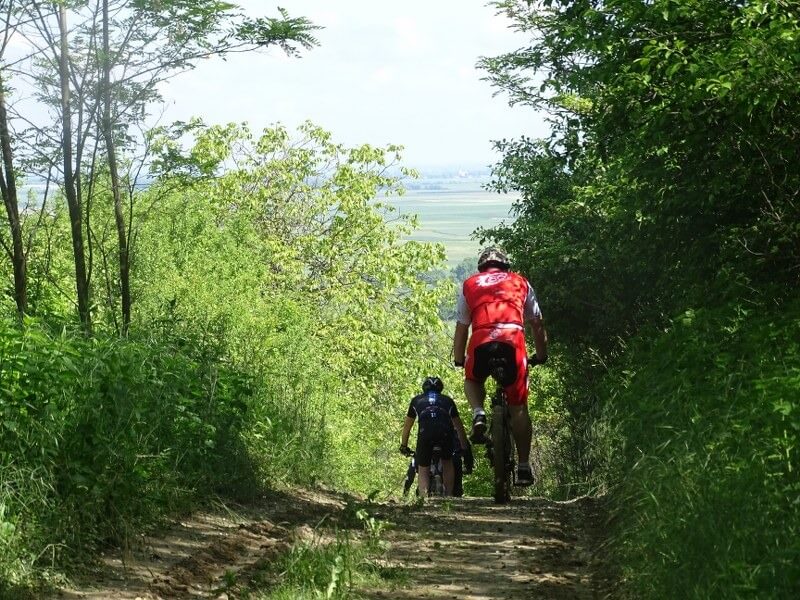
While we rested, we could see the transmitter, which was our next destination. The path to the transmitter allowed the participants to take a shorter ride on a trail that was either flat or sloping down. However, the relaxation did not last for too long, because before the transmitter it was necessary to climb again. After a short stop at the facility called Belje Villa at the foot of the transmitter, waiting to all the participants to gather, we continued the odyssey and hit the concrete path leading to the new Belje winery in Kamenac, but then turned sharply to the left and after an impressive ride ended up at the very tip of the Baranja hill, which is called Kamenjak. After that, we continued through the vast vineyards which were later replaced by meadows. After another glorious descent where we all kept nervously pressing our brakes (smell of burnt rubber could be felt), we found ourselves again in the plains, in Podolje.
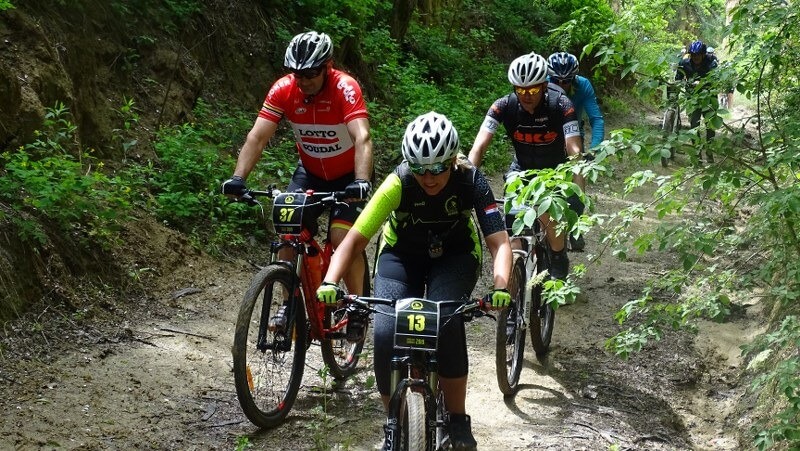
After a short rest on the asphalt road, we turned left following brown signage saying “Banska Kosa Wine Road”, and continued as before: climbing, avoiding the mud, meadows, vineyards … Then we stopped in a gigantic surduk so that we could all gather, refresh, and immortalise the moment with a photo. This was a culmination of the bike ride. All the surduks we passed through were “dwarves” compared to this one. Many participants could not imagine that something like that even existed in Baranja until they came and saw it for themselves.
After a half-circle along the surduk, we were again on the same asphalted road, and a large herd of lambs passed us on to the left. There are three theories about how the name Baranja came about, one Slavic and two Hungarian. The first is that it comes from the word “barany”, which means lamb in Hungarian, the second is that it comes from “boranya”, which in Hungarian means the wine mother. After the vast vineyards, we finally saw the lambs, which provided us with at least one “proof” in favour of the second Hungarian theory. Slavic theory suggests that the name Baranja comes from the word “bara” (bog). Even though we were far from Kopački Rit, we saw more than enough bogs. Despite all this, I am somehow more prone to believe that Baranja is first and foremost the wine mother.
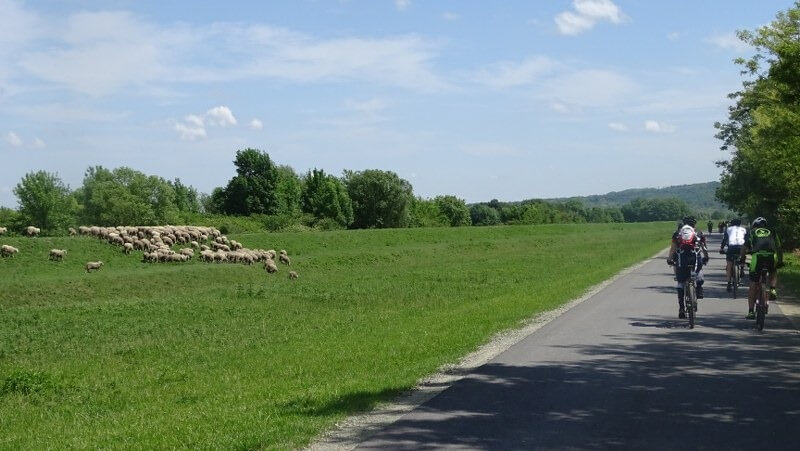
Even more surduks followed with vineyards and trails… The transmitter, as a landmark, was now on the opposite side than when we were watching it during the rest stop in Popovac. After the downhill ride, we found ourselves on the Kotlina-Podolje road, the first asphalt road that crossed Banovo Hill and the only place you have to touch the asphalt if you want to pass Banovo Hill on unpaved trails. One group went towards Kotlina on a more comfortable, asphalted road, while the second group continued on the trails, through more surduks and through the muddy loess. Where it was not wet, the ground was brittle, with clumps crushing into the dust under our tires. In Kotlina, near the pond, there was the second and final rest stop. Similarly as in Popovac, we were treated to water, a few dried fruits, banana, cookies, a piece of cheese, sausage, bacon and we were ready for new surduks.
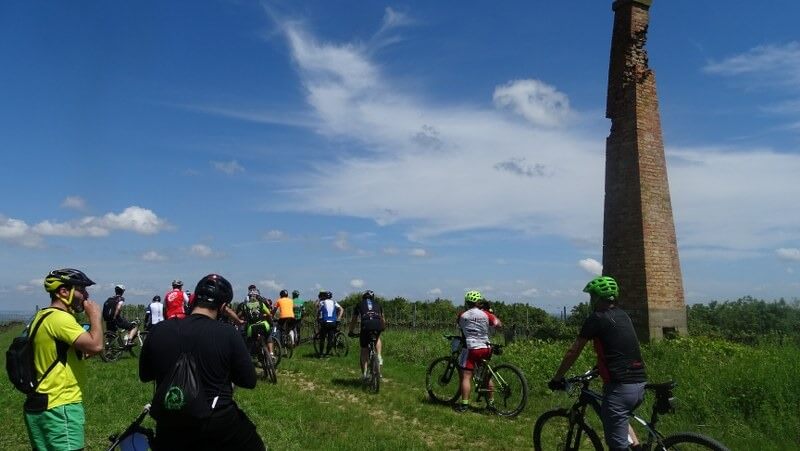
After a long and relaxing ride at the foothills, we used the last atoms of our strength to climb to the ridge of the hill, and we were rewarded with an asphalted Belje road on which we were several hours before. Driving through the winding and rolling vineyards, we came to the Belje viewpoint and continued after a short break. The culmination of this road section of the event was the crazy and unforgettable downhill ride on the Garmisch, as this part of Banovo Hill is often called.
At the beginning of the ride, I managed to get a puncture, which I realised while pushing the bicycle through a surduk. With the aid of tire sealant, I managed to solve the problem, but after two to three hours, I realized that it did not have a permanent effect, so the tire was again losing air. While descending the Garmisch, the tire was almost entirely flat, and the ride became risky. The left or right turn could get me out of balance. Did it make sense to give up at the very end, on the asphalt road?
We reached a new bike path connecting Beli Manastir with the Belje vineyards and bumped into a bicycle service station. The worker there pumped my tire (thanks, Krunoslav!) enough to be able to ride the final two or three kilometres. No surrender, let’s go. We did not return to the Lajmir lake by the standard route; we entered the town, and before the underpass that leads from Beli Manastir towards Belišće we turned right and went straight to the lake where the rest of the team, which decided to shorten the bicycle route, was already waiting for us.
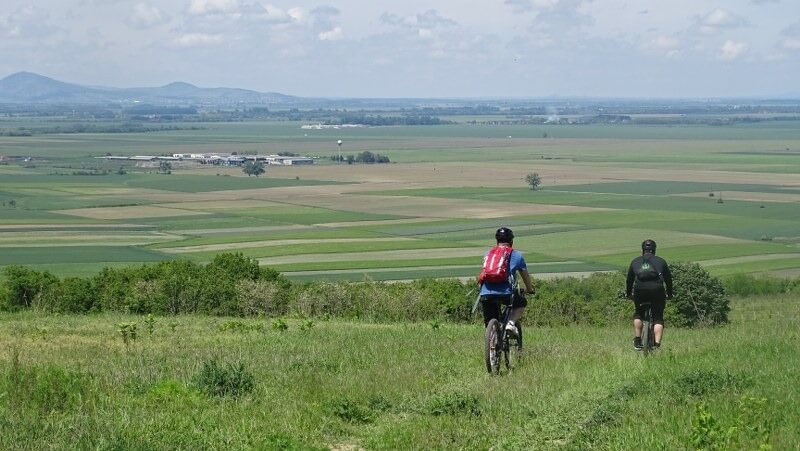
Then we were overwhelmed by a weird mixture of euphoria and fatigue, pride and exhaustion, the luck that we reached the end and the sorrow that we have left the enchanting world of the Baranja hill and its surduks and came back to the everyday life, its routine and monotony. But there will be more surduks, and this was just the beginning. We were particularly delighted by the comments of those who had been there for the first time, who said that this was fantastic and that they would visit the surduks in the future outside of organized events as well. That is the goal of this kind of events.
The Baranjski Surduci was an international event, bringing a group of cyclists from Sombor led by Robert Marton, the president of the Sombor Cycling Club, known to many cyclists as Gianni. We should also mention the oldest participant, Josip Mendelski Joka, a member of B.U.D.A. (the Donji Andrijevci Bicycle Association), who is seventy-one years old and who shamed many of much younger participants at the steepest climbs. The event also included members of the Baraber Extreme Team sports club from Belišće, the BizBike association from Bizovac, Road Team from Donji Miholjac, Kotrljaneri, Weekend Warriors and Osijek cycling club from Osijek, as well as many other unaffiliated riders.
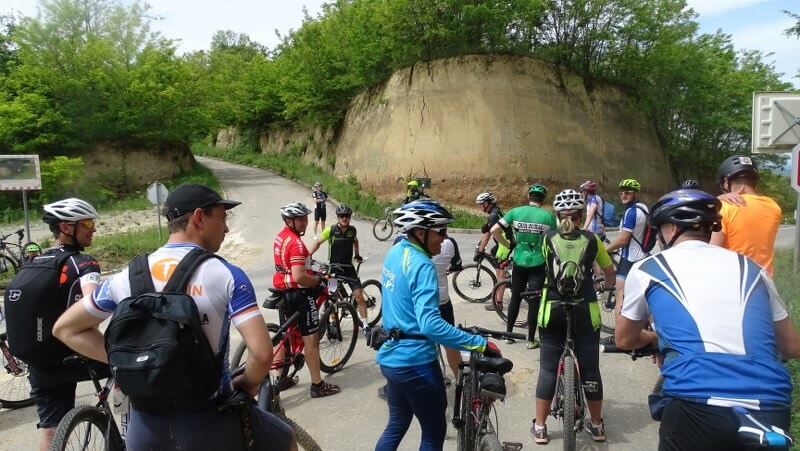
At the finish, we were welcomed by an excellent beans dish, and I do not say this just because I was starving, which is unsurprising after all the efforts made. Beans is a really interesting dish since it is more delicious if it is prepared for more people. Although this event was not a race, all participants had start numbers on bicycles. Why? We learned this only when we returned. There was a raffle organised, and fifteen lucky ones received prizes.
We should commend the association president Tanja Šoš on the organisational efforts, Zoran Kovač on the idea and leadership, and Krunoslav Perković, who took care that no one was left behind or got lost in the wilderness of the only hill in Baranja. Of course, we must not forget the volunteers from the Red Cross Society of Beli Manastir and the Oaza Peace Group NGO, and all those cyclists who enjoyed the gentle spring breeze on the paths offering fantastic views, drifted on steep and muddy surduks, cruised through endless vineyards, pushed their bicycles when the gravity did not allow them to proceed in a different manner…
Cramps and the consequent muscle inflammation, a few punctured tires, a few falls (with no serious injuries), and a bicycle failure here and there are entirely unimportant compared to all the beautiful things the participants have experienced on this event and all the memories they took with them. Or, how mountaineers and other outdoor fans love to say, “Tiredness passes, satisfaction remains”.
More cycling news can be found in the Lifestyle section.


